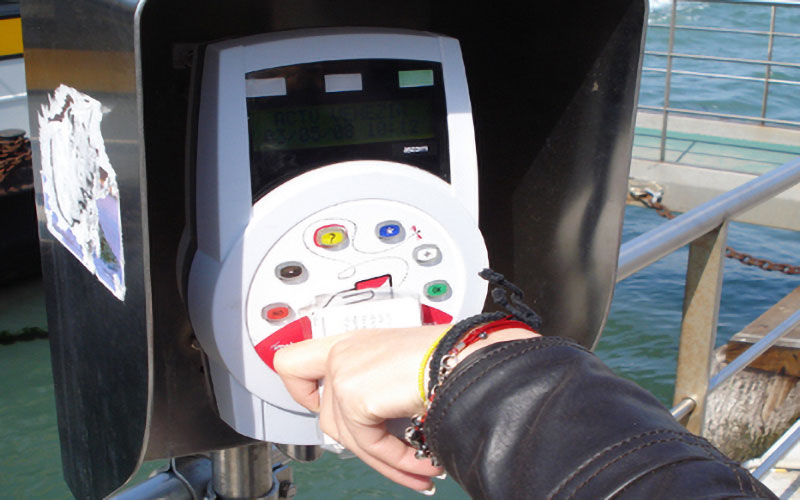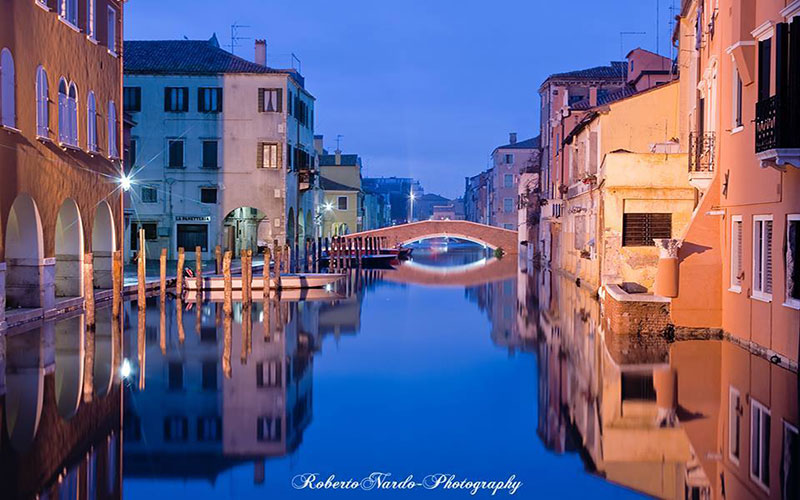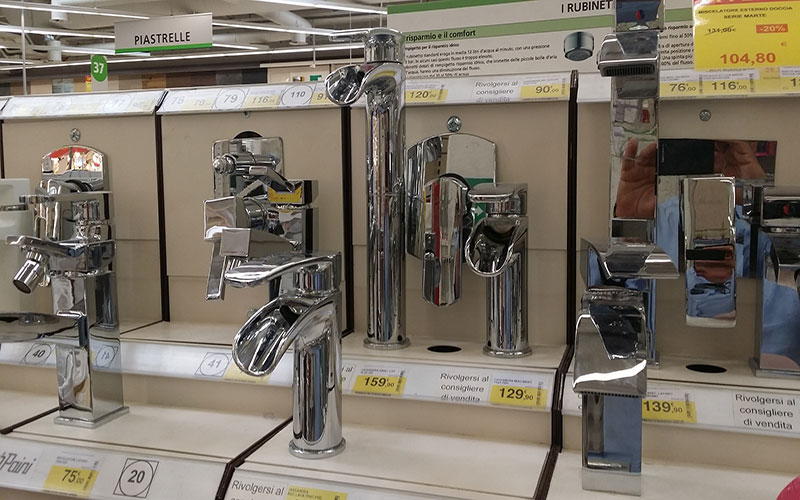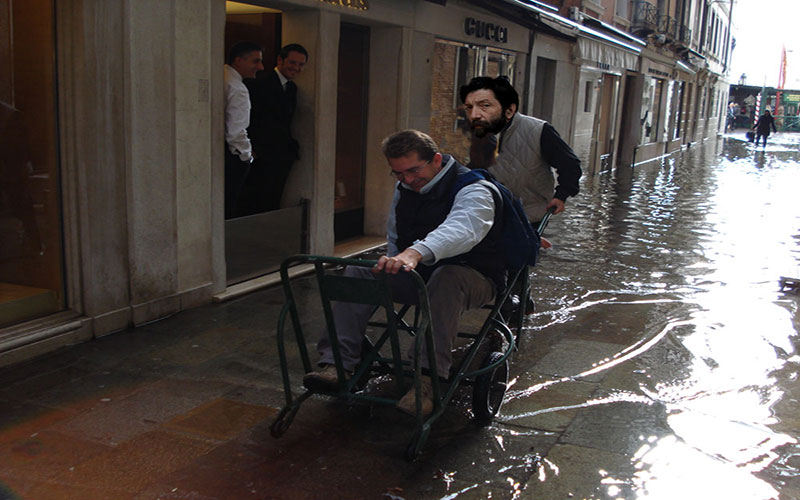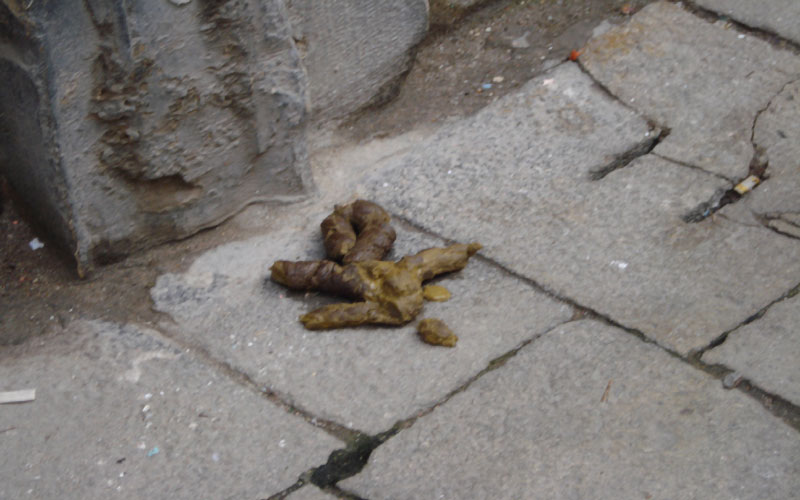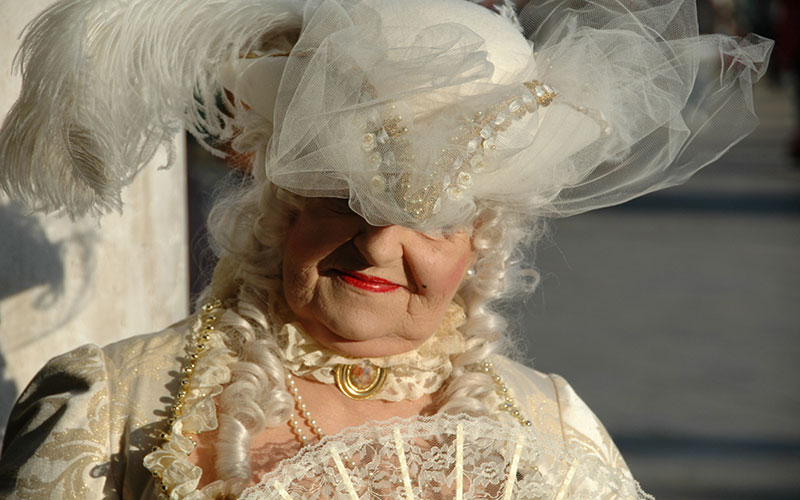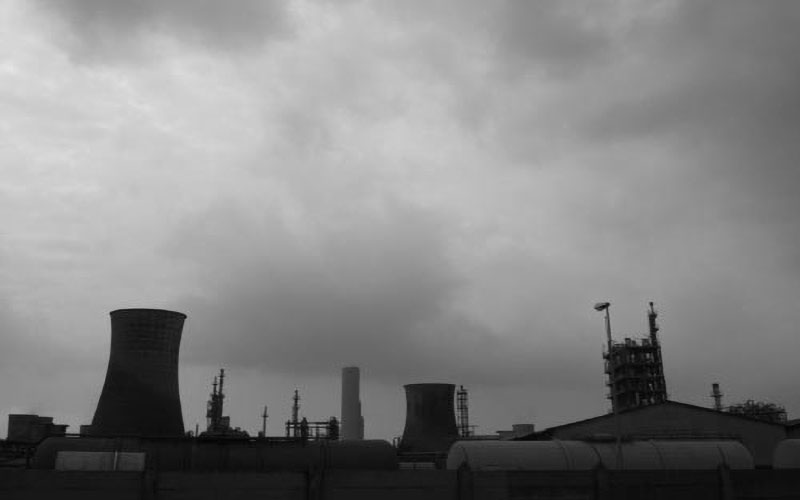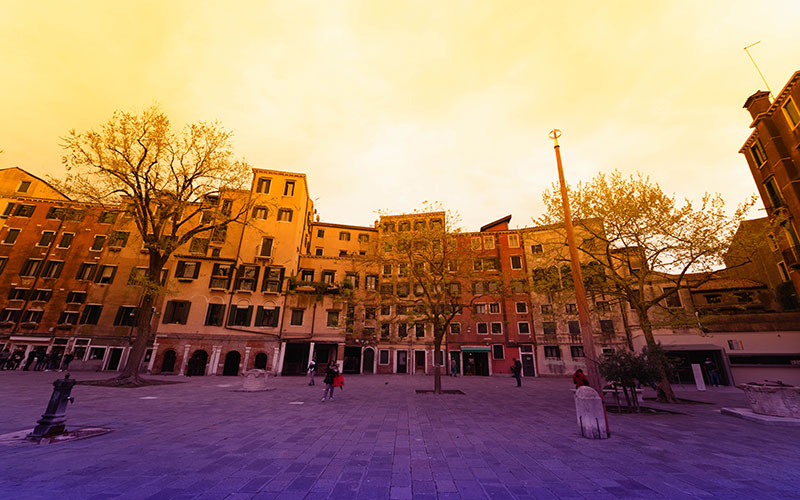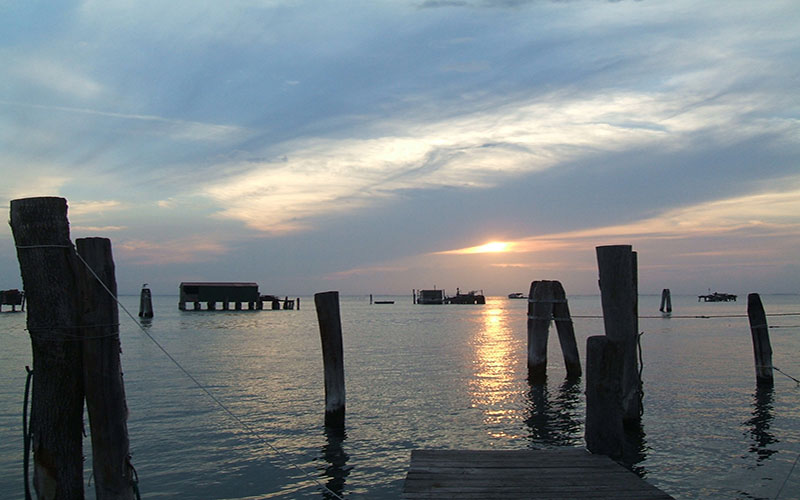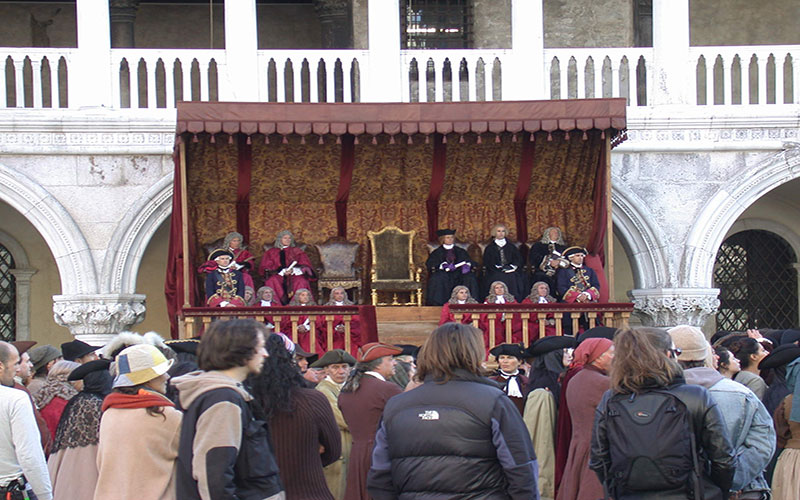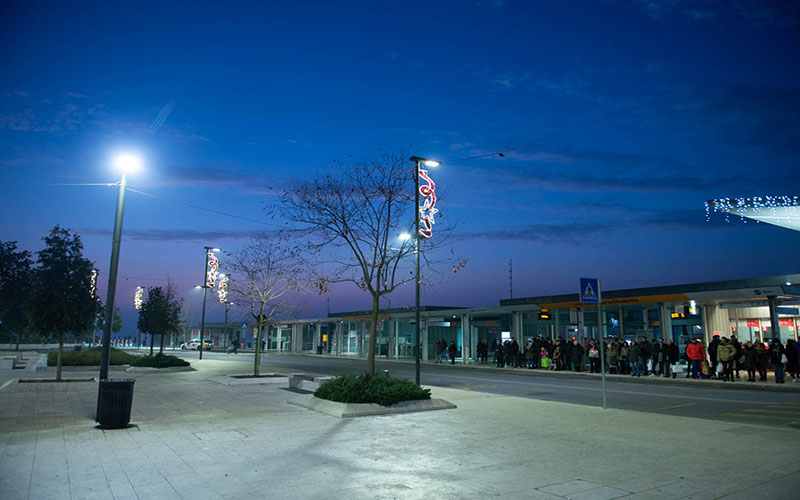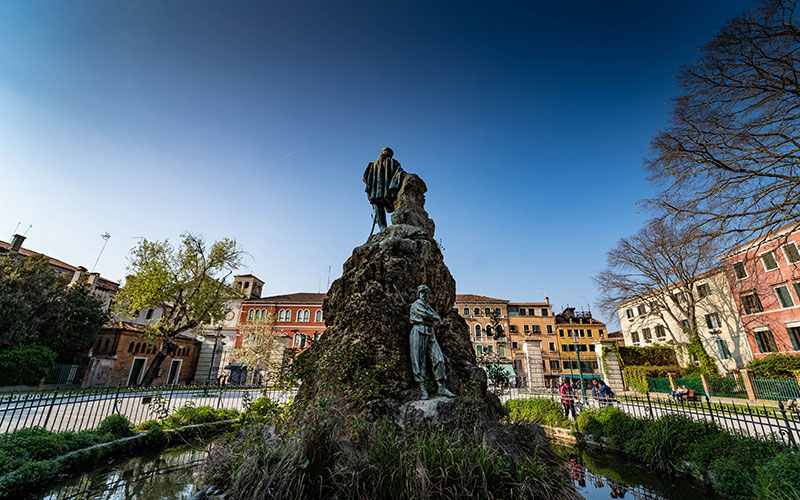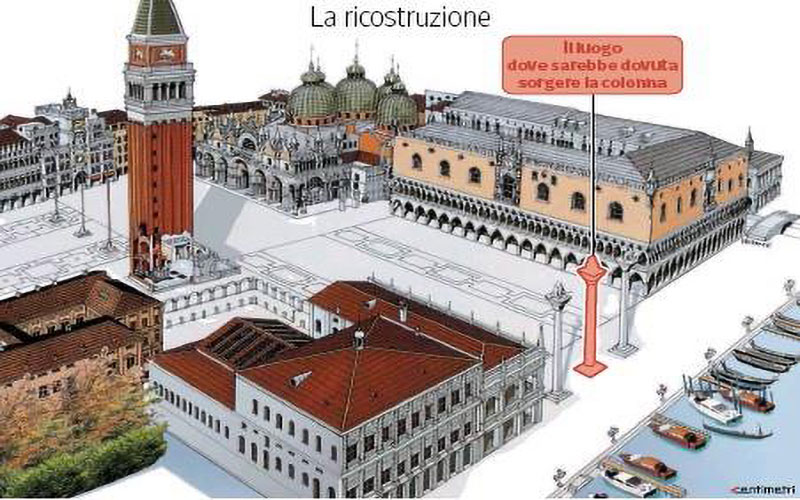Itinerary 2
Sacca Fisola / Zitelle (Giudecca)
Get off the vaporetto Line 2/41/42 at the Sacca Fisola stop. “Sacca” [bag] because in that place a current (circulation) of water was formed that gathered the mud of the lagoon together, forming an island. [I am told that this is not true; the island is man-made.] Sacca Fisola is a very young island and for that which people remember, an island not very firm (safe). Then the world is changed and the people with little to recommend them [undesirable people] were transferred to the mainland to then disappear. This, in the simplest and roughest way possible, is the recent history of Sacca Fisola.
Once you are off the vaporetto, you go along Calle del Vaporetto, finding a full stop [landmark?] of the island: the newspaper kiosk. Sacca Fisola has been a “red” island for a long time and signs are still seen in the form of the hammer and sickle or frames of glass showcases where one could read L’Unità etc for free. Now this too has been lost. Right now, Sacca Fisola is the Friday market and the municipal swimming pool. Like all of Giudecca, Sacca Fisola too is party to a total restyling and many open shipyards can be noticed, and new houses – not too beautiful as the new directive wants in the matter of style. [Does this mean that the new directive does not want the new houses to be too beautiful, or that the new houses are not very beautiful which is against the wishes of the new directive?] At the end of Calle del Vaporetto there is the tobacconist’s, round the corner [there are] the bar, the chemist’s and the baker’s. We are in the main square where on Fridays are set up the stalls of the market traders who sell [everything] from cheese to trousers, from sweets to shoes and who arrive from the mainland with their small vans by ferry. On the right is the sports ground.
We carry straight on to the next square with the Church of San Gerardo (in 1960s style, therefore horrendous) where we cannot fail to observe all those lowered shutters of shops, closed only because the small shops have a tendency t
o disappear because of the competition of bigger and more economical organisations. In front of us we have the wooden bridge that almost all Venetians know, being the one that unites the island with the other island called “della Piscina” [swimming pool]. In Venice, there used to be another on San Giorgio, which is now closed, and right now that of Sacca Fisola remains, if we don’t count the new one of Sant’ Alvise, the only swimming pool in the city. If we have in front the swimming pool and other buildings for sport example a section of bowls and five-a-side football (formerly [for] tennis…) on the left they have built other buildings with gymnasiums and a centre for learning to canoe.
We turn back if not after having walked far and wide having in front of us the lagoon in the silence more total except for the noise of the machinery of Vesta [Venezia Servizi Teritoriali ed Ambientali SpA – the business that collects and disposes of the rubbish of Venice] which transfers the rubbish from the small boats to the huge lighters, and the flapping of the wings of the hungry seagulls. We turn back from here to the wooden bridge and turn right to the small fondamenta. At the end to the left. Straight on among the sounds of 100 radios at high volume. On all the island [i.e. all Venice?], as on Giudecca, there is the custom to listen to music, above all that catchy style of Italian singers of the [19]60s and 70s, at high volume and with the windows open. In front of us a railing [above a wall], we turn right and cross the bridge that connects Sacca Fisola to Giudecca. The bridge is brand new. To build it took more years than it took for the one on the Straights of Messina. We cross it and we are on Giudecca.
On our left, beyond a swollen [i.e. decaying] wall, crooked and covered in weeds, the Molino Stucky [Stucky Mill]. Zigzagging between piles of rubbish we arrive at a Liberty-style bridge in reinforced concrete. The panorama towards the lagoon is not one of the most poetic: to the right the horrible new houses, to the left houses in ruins and an even more ruined fondamenta. Among the moored boats, a fishing business with its “vieri”, [Italian “vivai” – crab farms. Kind of large baskets, shaped like a flattened sphere with a 40 cm. hole on top. There, crabs captured with various traps were accommodated till the time of the ecdysis (shedding of the old shell), when they become commercial as “spiantani” (parts of the animal can be easily taken off its shell, already detached from the soft skin: pieces of this crab’s meat are the best bait for fishes like basses and eels) or as “moeche” (the crab while out of his shell, before the building of the new one begins: these completely soft crabs are fried and most Venetians go mad for such food). Usually made of bulrushes or other flexible branches, these “vieri”, by the hundreds, were a characteristic view of Giudecca’s canals and lagoon. In the 1970s they were substituted with boxes made of small wooden boards, to nearly disappear after the 1990s along with the disappearance of fishing families from the island. Recently the “vieri” were prohibited by law because of pollution, but some still exist in secret.] the boxes that hold the crabs while they are shedding their old shells.
We cross the bridge and we are on the Fondamenta delle Convertite. Now, half way along the fondamenta at No. 712, there is the women’s prison, formerly a convent for prostitutes converted to the Church. The first prior did not resist the flesh of the prostitutes but took advantage of about twenty of the residents and [having been] convicted he confessed to having drowned the fruits of his sins. He was beheaded and [his body] burned between the usual two columns on the quay of San Marco. In the [19]50s a similar thing happened with the priest of the present prison, but he was not burned. From the other side, the remains of a former brewery and the fine houses of the owners. On [the] canal we can also admire an unusual boat in the style of the ships of the Costa [coast]. At the end of the fondamenta there is a wooden bridge. From the wooden bridge we can look at the first house on the left: that was the shop of the greengrocer Cisboro, so called perhaps on account of his continuous bad language. On the right the boring Church of San Cosmo with another convent (Cosma and Damiano whit their beautiful real shop).
We are in the district called Lago Oscuro (Dark Lake) – who knows why? We go straight on up to the end of the street after the campo and turn right along Calle dell’ Accademia dei Nobili (Academy of the Nobles), a district where long ago young patricians who did not have much money were educated. There could be at most 46 students and they were supported by the Serenissima until they were 20 [years old]. The street cuts right across Giudecca and the walls hide the famous kitchen gardens [which are] now beautiful [ornamental] gardens. We turn into the first street we come to on the left, then right where there is a small campo with a table. We creep into the small street to the left and again to the right. We now find ourselves in a new district where the [former] mayor [of Venice], Paolo Costa, still lives… A new garden with benches and swings [Corte Grande] makes us stop and listen to the innocent shouts of children on the swings and slides. We turn left towards the north in the characteristic Corte dei Cordami [Cordage]. The corte is very typical and photogenic. On the houses to the right 13 chimneys can be counted. At the end of the campo with the well we have a house with a street on each side, we take the one on the right; taking the one on the left we will go onto [the] fondamenta with the view of the Canale della Giudecca near to the Palanca landing stage, so called because once there was one of the two traghetti (gondola ferries) that carried the people of Giudecca to, as one is accustomed to say even now, Venice [this presumably refers to the fact that Giudecca is not regarded as part of Venice], paying with a coin called a “palanca” (the other [landing stage] was at the Zitelle at the [far] end of Giudecca. We are in a small characteristic campo with the drinking-fountain, we take that small calle near the fountain and we emerge at the former base of Junghans [watchmakers], one of the many factories of Giudecca when the island was a small industrial district. Now there is a supermarket and apartments. We proceed beside the long wall of the former factory and we return into the little park [that we walked through] earlier, but this time we turn to the left and cross the bridge [Ponte delle Scuole].
We find ourselves in one of the many new areas of Giudecca with new buildings and old ones renovated [converted? Literally ‘re-adapted’]. If you want, take a walk and ponder whether they are beautiful or not. Having crossed the bridge, on the right there are the elementary schools. However, we go left into the only sottoportico that you see a little further ahead and we go straight on. Just around the corner we cross the new Ponte della Palada that lets us enter another typical little campo with [a] well and benches and we go into Calle Ferrando [There are two streets to choose from Calle Streta Ferrando or Calle Larga Ferrando, either will do.] where at the end we will find the wide Canale della Giudecca. We turn right.
We walk along Fondamenta del Ponte Piccolo and cross the Ponte Lungo. We are now on Fondamenta San Giacomo. Before Campo San Giacomo with its restaurant, Al Redentore, the Convent of the Clares, the sisters of seclusion [i.e. an enclosed order of nuns ]. Now let’s look at the restaurant, on the right there is Calle San Giacomo, we take it right up to the end, up to what does not touch us to turn to the left. At the end of the other street we turn right and we stop in the small communal park. We turn back to Campo San Giacomo and proceed to the famous Church of the Redentore [Redeemer], not before having passed the supermarket, the newspaper kiosk, the chemist’s, the clothes [dress] shop, the barber poet’s, and Fabio’s Bar.
Before crossing the next bridge we turn right onto Calle della Croce (Cross) and we take it right up to the end walking along the bank of the Rio della Croce. From the other side, half way along the fondamenta up to the lagoon side, a private iron bridge goes to the very beautiful Garden of Eden of the Countess, now disappeared, Espasia and which has been chosen as the magical setting of the series of fantastic tales of Moony Witcher, a genuine Giudeccan [Moony Witcher, the nom-de-plume of Roberta Rizzo, born in Venice in 1957, author of the tales of Nina the little alchemist], we turn back and cross the bridge. We are now on Fondamenta della Croce. At no. 76, after Ostello della Gioventù [Youth Hostel], the home of the author, more in front of that of Moony Witcher, more in front even than that of Elton John, Valentina Cortese and other artists. But let’s wait a moment and turn right through that big sottoportico between a minimarket and a newsagent’s. We go up to the end until which we do not emerge on the new shop window on the lagoon just restored. Here you can observe in silence, on the bank just newly replaced, the sound of the waves and the wind, if it breathes from scirocco. Here you have the same view that the ‘signori’ [guests] of one of the finest hotels in the world have, the Cipriani being the hotel just nearby.
One last effort. We turn back between houses just restored and about to be restored and we go out again towards the Basin of San Marco. We turn right, we go past Matteo’s Bar, the Church of the Zitelle (Spinsters) (understood as women to marry and to educate, hence former prostitutes of the time … again!), the house of Elton John (that 14th century house with the iron gate and the black cat) and we have reached the end of our itinerary. Let’s admire the panorama in silence with the bar of the Cipriani behind us. The gate at the end of the fondamenta gives access to the Finanza (Customs). We turn back and take the vaporetto to the right that goes to San Marco.One last effort. We turn back between houses just restored and about to be restored and we go out again towards the Basin of San Marco. We turn right, we go past Matteo’s Bar, the Church of the Zitelle (Spinsters) (understood as women to marry and to educate, hence former prostitutes of the time … again!), the house of Elton John (that 14th century house with the iron gate and the black cat) and we have reached the end of our itinerary. Let’s admire the panorama in silence with the bar of the Cipriani behind us. The gate at the end of the fondamenta gives access to the Finanza (Customs). We turn back and take the vaporetto to the right that goes to San Marco.
info
-
Associazione Venessia.com
Numero 2850
Delibera iscrizione 92 del 27/05/2010
Finalità Soldarietà/Promozione Sociale/Cultura
PI: 94072520276
-
Castello 2161, VENEZIA
mail: venessia.com@gmail.com







